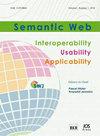NeuSyRE:基于场景图丰富化的神经符号视觉理解与推理框架
IF 2.9
3区 计算机科学
Q2 COMPUTER SCIENCE, ARTIFICIAL INTELLIGENCE
引用次数: 0
摘要
探索神经符号混合方法的潜力为无缝理解和推理视觉场景提供了一条大有可为的途径。场景图生成(SGG)是一种基于深度神经网络(DNN)的符号图像表示方法,涉及预测图像中的对象、属性和成对视觉关系,以创建场景图,并将其用于下游视觉推理。SGG 中使用的众包训练数据集高度不平衡,导致 SGG 结果存在偏差。由于可能的三元组数量庞大,要为每个视觉概念或关系收集足够的训练样本具有挑战性。为了应对这些挑战,我们建议用常识知识来增强典型的数据驱动 SGG 方法,以提高视觉理解和推理的表现力和自主性。我们提出了一种松散耦合的神经符号视觉理解和推理框架,该框架采用基于 DNN 的管道进行对象检测和多模态配对关系预测,以生成场景图,并利用异源知识图中的常识知识来丰富场景图,从而改进下游推理。在包括 Visual Genome 和 Microsoft COCO 在内的多个标准数据集上进行了综合评估,结果表明所提出的方法在关系召回分数(即 Recall@K 和平均 Recall@K)方面优于最先进的 SGG 方法,在 SPICE 和 CIDEr 分数方面优于最先进的基于场景图的图像标题制作方法,在 BLEU、ROGUE 和 METEOR 分数方面具有可比性。经过丰富后,定性结果显示场景图的表达能力得到了提高,从而使使用场景图生成的标题更直观、更有意义。我们的结果验证了使用异构知识图谱用常识性知识丰富场景图谱的有效性。这项工作为知识增强型视觉理解和推理的未来研究提供了基础。源代码见 https://github.com/jaleedkhan/neusire。本文章由计算机程序翻译,如有差异,请以英文原文为准。
NeuSyRE: Neuro-symbolic visual understanding and reasoning framework based on scene graph enrichment
Exploring the potential of neuro-symbolic hybrid approaches offers promising avenues for seamless high-level understanding and reasoning about visual scenes. Scene Graph Generation (SGG) is a symbolic image representation approach based on deep neural networks (DNN) that involves predicting objects, their attributes, and pairwise visual relationships in images to create scene graphs, which are utilized in downstream visual reasoning. The crowdsourced training datasets used in SGG are highly imbalanced, which results in biased SGG results. The vast number of possible triplets makes it challenging to collect sufficient training samples for every visual concept or relationship. To address these challenges, we propose augmenting the typical data-driven SGG approach with common sense knowledge to enhance the expressiveness and autonomy of visual understanding and reasoning. We present a loosely-coupled neuro-symbolic visual understanding and reasoning framework that employs a DNN-based pipeline for object detection and multi-modal pairwise relationship prediction for scene graph generation and leverages common sense knowledge in heterogenous knowledge graphs to enrich scene graphs for improved downstream reasoning. A comprehensive evaluation is performed on multiple standard datasets, including Visual Genome and Microsoft COCO, in which the proposed approach outperformed the state-of-the-art SGG methods in terms of relationship recall scores, i.e. Recall@K and mean Recall@K, as well as the state-of-the-art scene graph-based image captioning methods in terms of SPICE and CIDEr scores with comparable BLEU, ROGUE and METEOR scores. As a result of enrichment, the qualitative results showed improved expressiveness of scene graphs, resulting in more intuitive and meaningful caption generation using scene graphs. Our results validate the effectiveness of enriching scene graphs with common sense knowledge using heterogeneous knowledge graphs. This work provides a baseline for future research in knowledge-enhanced visual understanding and reasoning. The source code is available at https://github.com/jaleedkhan/neusire.
求助全文
通过发布文献求助,成功后即可免费获取论文全文。
去求助
来源期刊

Semantic Web
COMPUTER SCIENCE, ARTIFICIAL INTELLIGENCEC-COMPUTER SCIENCE, INFORMATION SYSTEMS
CiteScore
8.30
自引率
6.70%
发文量
68
期刊介绍:
The journal Semantic Web – Interoperability, Usability, Applicability brings together researchers from various fields which share the vision and need for more effective and meaningful ways to share information across agents and services on the future internet and elsewhere. As such, Semantic Web technologies shall support the seamless integration of data, on-the-fly composition and interoperation of Web services, as well as more intuitive search engines. The semantics – or meaning – of information, however, cannot be defined without a context, which makes personalization, trust, and provenance core topics for Semantic Web research. New retrieval paradigms, user interfaces, and visualization techniques have to unleash the power of the Semantic Web and at the same time hide its complexity from the user. Based on this vision, the journal welcomes contributions ranging from theoretical and foundational research over methods and tools to descriptions of concrete ontologies and applications in all areas. We especially welcome papers which add a social, spatial, and temporal dimension to Semantic Web research, as well as application-oriented papers making use of formal semantics.
 求助内容:
求助内容: 应助结果提醒方式:
应助结果提醒方式:


